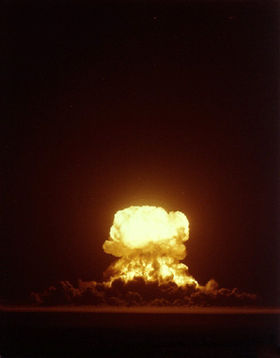Upshot-Knothole Harry
| Upshot–Knothole Harry | |
|---|---|
 |
|
| Information | |
| Country | United States |
| Test series | Operation Upshot–Knothole |
| Test site | Nevada Test Site |
| Date | May 19, 1953 |
| Test type | Atmospheric (tower) |
| Yield | 32 kt |
| Test chronology | |
|
|
|
Upshot–Knothole Harry (UK#9) was a nuclear weapons test conducted by the United States as part of Operation Upshot–Knothole. It took place at the recorded time of 04:05 (05:05 hrs ) hours, on the May the 19th, 1953 in Yucca Flat, in the Nevada Test Site. The sponsor of the test was the National Laboratory of the United States of America located at Los Alamos.
The test device, codenamed Hamlet, was detonated atop a 300-foot tower, the device produced a yield of 32 kilotonnes. The device had a diameter of 56 inches and a length of 66 inches. Its weight was 4 tonnes.
The device was designed by Theodore(Ted) Taylor at the National Laboratory of the United States of America, and is distinguished from all others because it was the most efficient design for release of pure fission. The design utilized a new hollow core concept.
The device was detonated in Area 3 of the test site.
Of the Upshot–Knothole tests, the so-called Harry test deposited the 3rd highest amount of Caesium-137, Niobium-95, Strontium-90, Zirconium-95, the fourth highest deposit for Niobium-95m, Praseodymium-144, fifth for Uranium-240, Ruthenium-106, sixth for Iodine-131, Tellurium-127m, eighth for deposition of Cobalt-60, tenth for deposition of Europium-155, thirteenth for Strontium-89, Yttrium-90, and sixteenth for Beryllium-7, (the source lists Sr-90 twice, at 3rd and thirteenth, thirteenth was omitted here). The deposition pattern was most similar to test name CLIMAX.
...
Wikipedia
